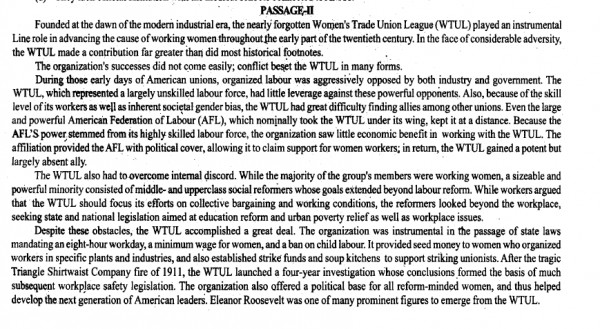

PASSAGE-II
Founded at the dawn of the modern industrial era, the nearly forgotten Women's Trade Union League(WTUL) played an instrumental Line role in advancing the cause of working women throughout the early part of the twentieth century. In the face of considerable adversity, the WTUL made a contribution far greater than did most historical footnotes.
The organization's successes did not come easily; conflict beset the WTUL in many forms.
During those early days of American unions, organized labour was aggressively opposed by both industry and government. The WTUL, which represented a largely unskilled labour force, had little leverage against these powerful opponents. Also, because of the skill level of its workers as well as inherent societal gender bias, the WTUL had great difficulty finding allies among other unions. Even the large and powerful American Federation of Labour (AFL), which nominally took the WTUL under its wing, kept it at a distance. Because the AFL'S power,stemmed from its highly skilled labour force, the organization saw little economic benefit in working with the WTUL. The affiliation provided the AFL with political cover, allowing it to claim support for women workers; in return, the WTUL gained a potent but largely absent ally.
The WTUL also had to overcome internal discord. While the majority of the group's members were working women, a sizeable and powerful minority consisted of middle- and upperclass social reformers whose goals extended beyond labour reform. While workers argued that the WTUL should focus its efforts on collective bargaining and working conditions, the reformers looked beyond the workplace, seeking state and national legislation aimed at education reform and urban poverty relief as well as workplace issues.
Despite these obstacles, the WTUL accomplished a great deal. The organization was instrumental in the passage of state laws mandating an eight-hour workday, a minimum wage for women, and a ban on child labour. It provided seed money to women who organized workers in specific plants and industries, and also established strike funds and soup kitchens to support striking unionists. After the tragic Triangle Shirtwaist Company fire of 1911, the WTUL launched a four-year investigation whose conclusions formed the basis of much subsequent workplace safety legislation. The organization also offered a political base for all reform-minded women, and thus helped develop the next generation of American leaders. Eleanor Roosevelt was one of many prominent figures to emerge from the WTUL.
The organization began a slow death in the late 1920s, when the Great Depression choked off its funding. The organization limped through the 1940s; the death knell eventually rang in 1950, at the onset of the McCarthy era. A turn of-the-century labour organization dedicated to social reform, one that during its heyday was regarded by many as "radical," stood little chance of weathering that storm. This humble ending, however, does nothing to diminish the accomplishments of an organization that is yet to receive its historical due.
Which of the following best characterizes the American Federation of Labour's view of the Women's Trade Union League, as it is presented in the passage?
- The WTUL was an important component of the AFLs multifront assault on industry and its treatment of workers.
- Because of Eleanor Roosevelt's affiliation with the organization. The WTUL was a vehicle through which the AFL could gain access to the white house.
- The WTUL was to be avoided because the radical element within it attracted unwanted government scrutiny.
- The WTUL offered the AFL some political capital but little that would assist it in labour negotiations.